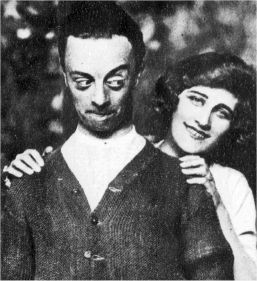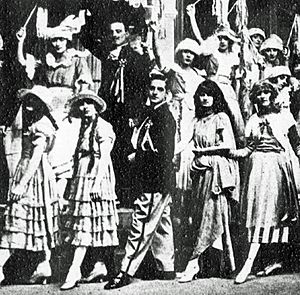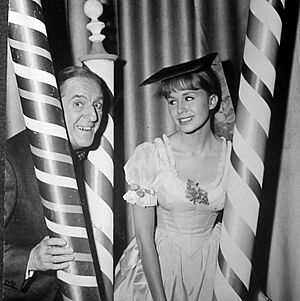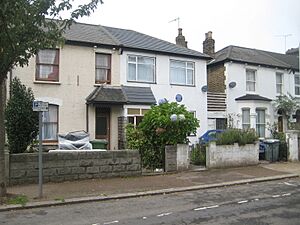Stanley Holloway facts for kids
Stanley Augustus Holloway (born October 1, 1890 – died January 30, 1982) was a famous English actor, comedian, singer, and storyteller (monologist). He was well-known for his funny and unique characters on stage and in movies. One of his most famous roles was Alfred P. Doolittle in the musical My Fair Lady. Stanley Holloway was also loved for his funny stories and songs, which he performed and recorded for over 70 years.
Born in London, Holloway first worked as a clerk. He started performing on stage before serving in the First World War. After the war, he became very successful in the musical Kissing Time. In 1921, he joined a group of performers called The Co-Optimists, and his career really took off. At first, he mainly sang, but soon people noticed his great acting skills and his ability to tell funny stories. Characters from his stories, like Sam Small (who Holloway created) and Albert Ramsbottom (created by Marriott Edgar), became very popular in Britain. Holloway became famous for recording these stories. By the 1930s, he was in high demand for variety shows, pantomimes, and musical comedies.
During the Second World War, Holloway made short films to help boost morale in Britain. He also played important characters in war movies like Major Barbara and The Way Ahead. After the war, he appeared in the film Brief Encounter and made several popular movies for Ealing Studios, including Passport to Pimlico, The Lavender Hill Mob, and The Titfield Thunderbolt.
In 1956, he was chosen to play the fun-loving Alfred P. Doolittle in My Fair Lady. He performed this role on Broadway (New York), in the West End (London), and in the 1964 movie version. This role made him famous around the world. His performances earned him nominations for a Tony Award (for stage acting) and an Academy Award (for film acting). In his later years, Holloway appeared in TV shows in the UK and the US. He also toured in stage shows and continued to make films into his eighties. Holloway was married twice and had five children, including the actor Julian Holloway.
Contents
Stanley Holloway's Life Story
Early Life and Family
Stanley Holloway was born in Manor Park, London, which was then in Essex, on October 1, 1890. His father, George Augustus Holloway, was a lawyer's clerk, and his mother, Florence May Bell, was a housekeeper and dressmaker. He was named after Henry Morton Stanley, a famous explorer. Some of his family members, like his great-uncle Charles Bernard, were also involved in theater.
Stanley's paternal grandfather, Augustus Holloway, was a wealthy shop owner. His family moved to London, and Stanley's father, George, married Florence Bell in 1884. They had two children, Millie and Stanley. His parents separated when he was young.
During his teenage years, Holloway went to the Worshipful School of Carpenters in Stratford, London. He also joined a local choir, which he later called a very important moment in his life. He left school at 14 and worked as a clerk in a boot polish factory. He started performing part-time in 1904 as "Master Stanley Holloway – The Wonderful Boy Soprano," singing emotional songs. Later, he worked at Billingsgate Fish Market before training to be a soldier in the London Rifle Brigade in 1907.
Starting His Career
Holloway's stage career began in 1910. He auditioned for "The White Coons Show" in Walton-on-the-Naze, a variety show put on by Will C. Pepper. This seaside show lasted six weeks. From 1912 to 1914, Holloway performed in summer shows in Clacton-on-Sea, where he was known as a romantic baritone singer.
In 1913, the comedian Leslie Henson asked Holloway to join his concert party called "Nicely, Thanks." Holloway greatly admired Henson and said he was a huge influence on his career. They became close friends and often asked each other for advice about jobs. Holloway even wrote a whole chapter about Henson in his autobiography, calling him "the greatest friend, inspiration and mentor a performer could have had." Later in 1913, Holloway went to Italy to train as an opera singer. But he soon decided he wanted to work in light entertainment and returned home after six months.
In early 1914, Holloway visited the United States and then went to South America with a concert party called "The Grotesques."
World War I and Entertainment
When the First World War started in August 1914, Holloway decided to return to England. At 25, he joined the Connaught Rangers and became an officer in December 1915. In 1916, he was in Cork, Ireland, and fought during the Easter Rising. Later that year, he was sent to France, where he fought in the trenches.
During the later part of the war, Holloway spent much of his time organizing shows to entertain the soldiers in France. He, Leslie Henson, and their "Star Attractions" group entertained British troops. This group included performers like Jack Buchanan and Binnie Hale, who would later form "The Co-Optimists." After the war, Holloway starred in "The Disorderly Room" with Leslie Henson.
Becoming a Star (1920s-1930s)
After leaving the army in May 1919, Holloway returned to London. He found success in two musicals in the West End: Kissing Time (1919) and A Night Out (1920). Holloway also made his first film appearance in a silent comedy called The Rotters in 1921.
From June 1921, Holloway had great success with The Co-Optimists. This was a group of performers he had met during the war. The show was very popular and ran for over a year, with more than 500 performances. The show was rewritten often to keep it new and exciting. "The Co-Optimists" finally closed in 1927 after 1,568 performances over eight years. In 1929, a movie version was made, and Holloway rejoined his old co-stars.
In 1923, Holloway started performing on BBC Radio. He developed his solo act throughout the 1920s. In 1924, he made his first music recordings. After "The Co-Optimists" ended in 1927, Holloway starred in the musical comedy Hit the Deck.
Holloway began regularly performing his famous monologues (funny stories told by one person) on stage and on record in 1928. He created the character Sam Small in his story "Sam, Sam, Pick oop thy Musket." Over the years, he recorded more than 20 stories about Sam Small, most of which he wrote himself. He created Sam Small after Leslie Henson told him a story about an old soldier. Holloway gave Sam a northern English accent.
In 1929, Holloway played another main role in the musical comedy Song of the Sea. He also performed in the show Coo-ee. When "The Co-Optimists" reunited in 1930, he rejoined them. In 1931, he introduced the London audience to the monologue The Lion and Albert. This story was written by Marriott Edgar, based on a news story about a boy eaten by a lion at the zoo. In the story, Mr. and Mrs. Ramsbottom react calmly when their son Albert is swallowed. Both Edgar and Holloway weren't sure if the story would be a hit, but it was very well received. Edgar later wrote 16 more monologues for Holloway. These characters, Sam and Albert, became part of English popular culture in the 1930s. Holloway often performed these stories in costume, with funny clothes and big mustaches.
Films and Pantomime
Starting in 1934, Holloway appeared in several British films. Three of these films featured his character Sam Small. He began working with Ealing Studios in 1934, appearing in Sing As We Go with Gracie Fields. Other films from the 1930s included Squibs (1935) and The Vicar of Bray (1937). In December 1934, Holloway performed in his first pantomime (a type of musical play), playing Abanazar in Aladdin. He quickly became a favorite in this role, playing it in many cities.
World War II and Post-War Films
When the Second World War started in 1939, Holloway was 49, too old for active fighting. Instead, he made short films to help boost morale in Britain. He narrated documentaries like Albert's Savings (1940), which featured the character Albert Ramsbottom, and Worker and Warfront No.8 (1943).
On stage during the war, Holloway appeared in shows like Up and Doing and Fine and Dandy with Leslie Henson. In these shows, Holloway performed new monologues.
In 1941, Holloway played a policeman in the film Major Barbara. He had main roles in later war films, including The Way Ahead (1944), This Happy Breed (1944), and The Way to the Stars (1945). After the war, he played Albert Godby in Brief Encounter and had a small role as the First Gravedigger in Laurence Olivier's 1948 film of Hamlet. In 1951, Holloway played the same role on stage. He also narrated documentaries in a series called Time To Remember.
Holloway starred in a series of films for Ealing Studios, starting with Champagne Charlie in 1944. After that, he made Nicholas Nickleby (1947) and Another Shore (1948). He then appeared in three of the most famous Ealing Comedies: Passport to Pimlico (1949), The Lavender Hill Mob (1951), and The Titfield Thunderbolt (1953). His last film with Ealing Studios was Meet Mr. Lucifer (1953).
In 1948, Holloway toured Australia and New Zealand for six months. He even wrote a new monologue called Albert Down Under especially for the tour.
My Fair Lady and International Fame
In 1954, Holloway joined the Old Vic theater company to play Bottom in A Midsummer Night's Dream. This production traveled to New York and toured the US and Canada. Holloway made a strong impression in this role. He later said that this American tour led to him getting the part of Alfred Doolittle in My Fair Lady.
In 1956, Holloway created the role of Alfred P. Doolittle in the first Broadway production of My Fair Lady. The writer, Alan Jay Lerner, said Holloway was his first choice for the role. Holloway had a long connection with the show, appearing in the original 1956 Broadway production, the 1958 London version, and the 1964 film version. He chose the My Fair Lady film over a role in Mary Poppins. His performances earned him nominations for a Tony Award and an Academy Award.
In 1960, Holloway played Pooh-Bah in a US television production of The Mikado. His films around this time included Alive and Kicking (1959) and No Love for Johnnie (1961). In 1962, Holloway recorded the role of Fagin in a studio recording of Oliver!.
Later Career and Final Performances
In 1962, Holloway played an English butler named Higgins in a US television comedy called Our Man Higgins. His son Julian Holloway also appeared in the series. In 1965, he appeared in the war film In Harm's Way with John Wayne.
In 1967, Holloway appeared in a major British television series, the BBC's adaptation of P. G. Wodehouse's Blandings Castle stories, playing Beach, the butler. After My Fair Lady, Holloway got film roles in Mrs. Brown You've Got A Lovely Daughter (1968), The Private Life of Sherlock Holmes, Flight of the Doves, and Up the Front (all in the early 1970s). His final film was Journey into Fear (1974).
In 1970, Holloway began working with the Shaw Festival in Canada. He continued to perform into his eighties, touring Asia and Australia in 1977. He made his last performance at the Royal Variety Performance in London in 1980, when he was 89 years old.
Holloway died from a stroke on January 30, 1982, at the age of 91. He is buried with his wife Violet in East Preston, West Sussex.
Stanley's Family Life
Holloway was married twice. His first wife was Alice "Queenie" Foran. They met in 1913 and married in November 1913.
Holloway and Queenie had four children: Joan, Patricia, John, and Mary. They moved to Hampstead, West London. In the late 1920s, Holloway had some financial difficulties. Queenie died in 1937 at the age of 45.
On January 2, 1939, Holloway married the actress Violet Marion Lane (1913–1997), who was 25 years old. They moved to Marylebone. Violet helped manage Holloway's career. In his autobiography, Holloway said she was not only his wife but also his "best friend" and helped him with many things. Together, they had one son, Julian Holloway, who also became an actor. Julian's daughter is the model and author Sophie Dahl.
Holloway, Violet, and Julian mainly lived in the village of Penn, Buckinghamshire. Holloway also owned other properties, including a flat in London and one in New York during his My Fair Lady years on Broadway. He spent his final years in Angmering, West Sussex. Holloway had close friendships with many performers, including Leslie Henson, Gracie Fields, Laurence Olivier, and Arthur Askey. When he worked in the US, he became friends with Frank Sinatra, Dean Martin, and Groucho Marx.
Awards and Legacy
Holloway was given the Order of the British Empire (OBE) award in 1960 for his services to entertainment. In 1978, he received a special award from the Variety Club of Great Britain.
There is a memorial plaque for Holloway in St Paul's, Covent Garden, London, which is known as "the actors' church." In 2009, English Heritage put up a blue plaque at 25 Albany Road, Manor Park, Essex, the house where he was born in 1890. There is also a building named after him in Newham, London, called Stanley Holloway Court.
Holloway named his autobiography Wiv a Little Bit o' Luck after a song he sang in My Fair Lady. He also oversaw the publication of three books of his monologues: Monologues (1979), The Stanley Holloway Monologues (1980), and More Monologues (1981).
His Famous Recordings
Holloway had a long recording career that lasted 54 years. He started recording when technology was still very basic and continued into the age of stereo sound. He mainly recorded songs from musicals and shows, and he recited many monologues. His most famous recordings (besides his work on My Fair Lady) are his three series of monologues. These featured his characters Sam Small and Albert Ramsbottom, and stories about historical events like the Battle of Hastings and the Battle of Trafalgar. In total, he made 130 recordings between 1924 and 1978. Critics praised his "fine voice" and his ability to use it well, noting his clear speaking, good phrasing, and artistic understanding.
Images for kids
See also
 In Spanish: Stanley Holloway para niños
In Spanish: Stanley Holloway para niños










